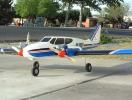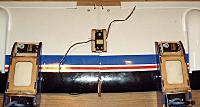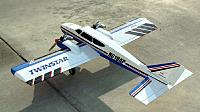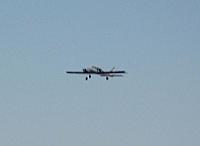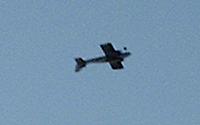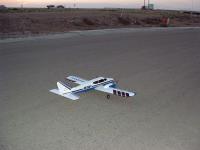|
|
|
|
|
Hobbico Twinstar II ARF Review
!Introduction
| spec2 | @914975 |> <b>Wingspan:</b> |< 56" |> <b>Wing Area:</b> |< 560 sq. in. |> <b>Advertised Weight:</b> |< 5 - 5.5 lbs |> <b>Weight As Tested:</b> |< 5.81 lbs (93 oz.) |> <b>Length:</b> |< 40" |> <b>Wing Loading As Tested:</b> |< 23.91 oz/sq. ft. |> <b>Servos:</b> |< 5 - Hobbico C60 Standard |> <b>Transmitter:</b> |< Hitec Eclipse 7 |> <b>Receiver:</b> |< JR R700 |> <b>Battery:</b> |< 5 X 1000mah NIMH |> <b>Engine:</b> |< 2 - OS Max .25 LA 2 Stroke Engines |> <b>Manufacturer:</b> |< <a href=http://www.hobbico.com>Hobbico</a> |> <b>Available Online From:</b> |< <a href=http://www.towerhobbies.com>Tower Hobbies</a> If you fly model airplanes, eventually the twin bug will bite. The thought of two engines growling powerfully as your plane speeds through the air just becomes too much to resist. The twin bug has been whispering in my ear for some time, but issues such as high cost, complexity, and fears of spiraling crashes if one motor fails have held me back. Hobbico, with their original release several years ago of the "Twinstar ARF", swept all these issues aside. This newly released 2nd generation of this beloved ARF is inexpensive, simple to build and operate, rock solid on just one engine, sports iron on covering, and really a great looking model. I'm usually not one to belabor a point, but the completed Twinstar really must be seen in person to fully appreciate. I'm even tempted to class it as standoff scale since it reminds of private twin engine passenger planes. So if the twin bug has been whispering in your ear as well, follow along and see if the Twinstar II might be the perfect first twin for you. !Kit Contents The Twinstar was a very complete ARF and little was left to buy after purchasing the kit. It makes more sense to list what is left to buy than list everything that was in the kit. The few items required to complete the model were: <ul> <li> Two engines and propellers (.15 - .25 two-stroke or .26 - .40 four-stroke) <li> Minimum four channel radio with five servos, receiver battery, and a four channel receiver <li> Y-harness <li> Latex foam rubber <li> Fuel tubing <li> Basic building tools and supplies <li> Basic glow engine flight line equipment </ul> @914976:The box was pleasing with attractive graphics. @914977:A lot of plane was packed in a surprisingly small space. @914978:All parts accounted for and in perfect condition after shipping. !Assembly As I've come to expect, Hobbico's supplied instruction <a href=http://www.hobbico.com/manuals/hcaa2076-manual.pdf>manual</a> was very thorough, provided lots of helpful photos, and was available online to read before actually buying the Twinstar. After completing the model it was clear that if the instructions were followed faithfully, a solid and true flying aircraft would be the result. Because of the excellent manual and the fact that this model was in my opinion not for beginners, I thought it best not to duplicate the effort here. Instead I decided to touch on points I felt worthy of mention in the construction portion of this review. !!Wing @914979:These small spring-loaded clamps came in handy. The wing halves were very easy to assemble since I had many small clamps available to hold things in position. At first I was considering glassing the center section of the wing after it was assembled. However, I decided that the hefty wing joiner, ample glue points, and plywood servo mount that was glued between the halves supplied enough strength for aerobatics as designed. Of note was that many of the screws needed for assembly and called for in the instructions were missing from the hardware package. The missing hardware were very common items, so I was able to replace them from my spares drawer. Hobbico assures me that customer's production aircraft should be complete, and any missing items would be replaced promptly. !!Engine Installation @914980:Two OS Max .25 LA two-stroke engines were supplied for this review. @914981:The thrust line offsets to allow one engine flight can be seen in this photo. Also note the quick links on the carb control arms. All necessary hardware, fuel tanks, motor mounts, and spinners were provided in the ARF kit. The adjustable mounts were very nice and the fuel tanks fit just right in the nacelles. The only problem I had was connecting the linkages. The instructions called for using a clevis on the end of the supplied pushrod wire. This was to be connected to the control arm on the engine's carburetor and then the wire bent to provide free movement to each throttle servo. There simply was not enough clearance between the clevis and the engine crankcase no matter how I bent the wire to get free movement. I ended up installing quick links on the control arms and just running the pushrod wire directly into each link. This eliminated the interfering clevis and made for a much freer and straighter run to the carb from the throttle servo. !!Fuselage @914982:The nose gear wire required modification twice. The only thing of note here was that the supplied nose gear needed substantial filing. The flat spot for the control arm set screw had been stamped into the wire. This deformed the wire just enough so it would not slip through the collar in the control arm. I twisted and pushed for several minutes and then twisted and pulled for several minutes to get it out when it wouldn't go all the way into position. A few minutes with the dremel tool took care of that problem. Later when I was attempting to set the rudder throws, I couldn't get enough throw in one direction. The problem was traced to the nose gear. Once again the flat spot for the set screw was causing problems. It wasn't stamped off center enough to allow the control arm enough movement room when attached. Out came the nose gear again and the dremel tool came into play a second time to solve the problem. !!Radio Installation @914983:Three servos are installed in the wing, two throttle and one aileron. A Y-harness is called for in the instructions, but I chose to hardwire the connection between the two throttle servos for simplicity and reliability reasons. @914984:There was plenty of room for anything and everything in the spacious fuselage. Radio installation was a breeze on the Twinstar. There was plenty of room for standard size servos in every specified location. Hobbico C60's were used throughout to keep the cost down and provide plenty of torque for all surfaces. !!Old vs. New As you may know, the model now sold is the second generation of this great model in ARF form. Many improvements had been made and several construction steps eliminated by doing them at the manufacturer. Here is a quick list of the changes: <UL> <LI>The plywood wing root ribs with hold down tab were now one piece to increase strength and were preinstalled. <LI>The aileron servo pocket was precut. <LI>The engine nacelle pockets on the wing were reinforced and precut. <LI>The throttle servo pockets were precut. <LI>Wing hold down hardpoints, braces, and hardware were preinstalled. <LI>The servo tray was already installed. <LI>Nose gear linkage was improved and completely hidden in the nosecone. <LI>Nose cone was now one piece, fiberglassed by the manufacturer, and heavy internal nose bracing eliminated. <li>Covering is now a low-temp iron on material rather than 'sticky-backed'. </UL> The changes were a definite improvement in quality, performance, and strength not to mention cutting several hours off construction time! This added tremendous value in my opinion. !!Completion At this point all that was left was adding preformed parts like nacelle covers and hooking up the engines to the fuel tanks. The only thing I added to complete the Twinstar that wasn't called for in the instructions was some wing saddle foam tape. When completed I set the Twinstar on my CG machine and it balanced right at the rear part of the specified range (3 7/16" from the leading edge) which was right where I wanted it. Then I weighed the Twinstar and was surprised that it came in five ounces over the highest listed weight. This concerned me a little, but there was nothing I could do about it. I hadn't been wild with the glue and my airborne gear wasn't super heavy. I'd just have to see what happened. There really wasn't much to completing the Twinstar, it truly was an ARF kit. It only took me two weeks of leisurely one hour evenings to complete it. This included a day of breaking in the .25's on the plane. If someone were highly motivated to get it in the air, I'm sure it could easily be completed in under a week. When I attached the wing to the completed model for the first time and took it outside for the following photos, I just couldn't get over how great it looked! If it flew anywhere near as good as it looked, I was in for a real treat! @914985:Oooooo! @914986:Ahhhhh! !Flying !!First Session To my good fortune, the first weekend after I completed the Twinstar had beautiful flying weather. I showed up bright and early at the flying field and flew a couple of other models to get warmed up. Before flying the Twinstar throws were checked and adjusted to the high rates listed in the instructions. The CG was also double checked to make sure it was still at the rear of the range listed in the instructions. At last I got my nerve up and fired up the .25's. This was the first time I had both engines running at the same time and boy, what a sweet sound it was! Having run out of excuses and things to check it was time to launch. I lined up down the runway and smoothly advanced the throttle to full. The Twinstar accelerated straight ahead and required no rudder input. I waited for it to lift off on it's own and when it didn't I pulled just a touch of elevator and the Twinstar rose gracefully into the air. @914987:The Twinstar was rock steady from the first flight. After a few circuits I was already feeling comfortable due to the smooth and stable flight characteristics of the Twinstar. The sound of the twin engines put a big smile on my face and drew appreciative comments from the flight line. I then got up to a couple of mistakes high and input full aileron. This rewarded me with a slow but smooth and steady roll. The nose dropped slightly while inverted so I input a few clicks of down trim and tried another. This got me very close to neutral pitch stability either upright or inverted. Awesome!! In fact those two clicks of down trim where the only adjustments needed. Next I pulled a fairly tight loop and the Twinstar powered right through it without a hitch. I wanted to get a feel for landing speed before it was actually time to land, so a few touch and go's were then tried. I didn't have the throttle travel set quite right and the two .25's were still revved up slightly even at the lowest stick position. This made the approaches pretty speedy, though not unreasonable. Three touch and go's were completed without a hitch or a bounce and I was getting a pretty good feel for the Twinstar's habits. @914988:Setting up for another touch-n-go. After the third touch and go I punched the throttle to swing around for another landing pass when suddenly the Twinstar seemed sluggish. I finished the circuit and lined up for another touch and go. As the plane came closer the reason for the sluggishness was clear, only one engine was running. The realization startled me and the touch and go turned into a rough landing. The rough landing was totally my fault because I lost my concentration when I saw only one engine running. The Twinstar was actually flying just fine on one engine. In fact, the pilots at the other end of the runway said that I lost the engine shortly after I took off from the last touch and go. So I had actually made a complete circuit and lined up for the landing on just one engine, without even knowing it! At first I thought one engine had run out of gas before the other, but closer inspection showed the real cause. Parts of the spinner were missing and the prop was destroyed. That ended the flying for the day because I didn't have extra spinners or props. @914989:The backplate of the included spinner was shattered. Back at the shop I disassembled the other spinner and prop assembly. It was full of stress fractures and probably would have disintegrated soon after the first if I had kept flying. In my opinion the plastic used to make the included spinners was brittle and substandard. Fortunately there was no other damage. I installed some newly acquired spinners and props and the Twinstar was ready for another trip to the field. !!Session Two One engine decided it didn't want to idle and would die at anything under half throttle (later determined to be a bad plug). I tweaked and tweaked to no avail, and all the while the wind speed continued to increase. I was determined, though, and managed to get the engine to idle long enough for a quick takeoff. @914990:The Twinstar really moves along at full throttle! Once in the air I made several low passes in an attempt to let my video person (wife) get some footage. Even into the wind, the Twinstar really moved out! Decent footage was hard to come by with such a fast plane. This being the second flight, my confidence was much higher and I began doing some giant cuban 8's. The Twinstar had no trouble performing the maneuver although it was obvious there was not enough power for straight vertical ascents. @914991:The Twinstar at the top of a giant loop. Satisfied with that aspect of the Twinstar's flight envelope, It was back to low passes in an attempt to get some footage. I responded to my wife's complaints of "TOO FAST TOO FAST" by backing off the throttle and of course that engine immediately died. This time when the Twinstar felt sluggish I knew what had happened and was prepared. What I wasn't prepared for was the wind deciding right then to shift across the landing strip and double speed. Talk about the ultimate one-engine-dead-on-a-twin flight test!! I wish I could have said that I made the perfect crosswind skidding landing, but I would have had to tell a big lie. Side slipping into a 25 mph wind was just too much drag for one engine on this plane and I landed well short of the strip in the dirt. It was a bit rough, but all that happened was slightly bent landing gear and a few minor scuffs. Whew!!! @914992:Out front tuning the engines. Back at the shop (garage) the landing gear were straightened and everything cleaned up. The engine problem was traced to a bad glow plug and extras were ordered. After the new plugs arrived the engines were tuned and matched with a tachometer. The Twinstar was ready for round three at the flying field. !!Session Three @914993:Stills like this were hard to come by due to the Twinstar's speedy flight envelope. The next weekend brought very hot but calm conditions and I gathered up my wife, video gear, and the Twinstar for a shooting session. It was a beautiful evening and the Twinstar performed flawlessly with the two engines finally broke in and tuned to perfection. The following visual media was gathered from this outing as well as most of the flight performance report. !!Taking Off and Landing @914994:The Twinstar lined up for a takeoff. Taxiing with the engines idling was outstanding! In fact putzing around on the tarmac was almost as much fun as flying. When taxi time was over, the Twinstar tracked straight and true on takeoff runs with very little rudder input needed one way or the other. Takeoff runs were fairly long however and required some elevator input to get the Twinstar airborne. This may have been due to my Twinstar being a little overweight. @914995:Lining up for a landing. Just as the Twinstar needed a decent run to lift off, it also needed plenty of room to bleed off speed and roll to a stop. The airframe was very clean and just kept on going and going! A typical landing consisted of setting up past the far end of the runway, cutting the engines, turning on final with the nose level, making sure to keep the speed up, and then a good flair a couple of feet off the ground leaving plenty of room for the roll out. I never let the speed get too slow on final or yanked back on the stick during the flair. Greasing the landings was a snap thanks to the tricycle landing gear. @914996:Greased another! !!Aerobatics/Special Flight Performance The Twinstar, in my opinion, was neither envisioned nor designed as an aerobatic plane. If I had to put it in a category I'd say it was closest to a standoff scale model of a twin engined civilian plane. What it was billed as, and filled this bill fabulously, was a twin engined "trainer". The trainer part referring to a painless introduction for the experienced modeler to their first twin engine plane. It does this job wonderfully due to the preset thrust lines and simple throttle setup from the manufacturer. If not for these important design features my Twinstar would have certainly never made it past the first test flight. I was primarily an electric flyer and had to go through a learning curve with breaking in and tuning glow engines. Consequentially the Twinstar lost one engine several times during the flight trials. Instead of disaster, continued flight and easy landings were the norm and flight testing continued with no repairs needed. @914997:Turning for another pass with the twin engines growling powerfully. In spite of all that, however, the Twinstar does have some surprising aerobatic capability. I attribute this to the power of the two engines and its symmetrical wing with very little dihedral. Rolls were slow and stately, but almost perfectly axial with little elevator input needed while inverted. Loops could be as large or small as desired (within reason). The Twinstar couldn't go vertical, but flying through giant loops was no problem. Inverted flight was rock solid with just a touch of elevator required to maintain altitude. Knife edges were definitely not possible which was not surprising since the rudder was minimal. However the rudder is quite sufficient for skidding approaches and ground handling. @914991:Upside down anyone? Last but not least was the speed of the Twinstar. With the two engines, the fairly thin symmetrical airfoil, and the clean airframe, the Twinstar was FAST! It wasn't a pylon racer or anywhere near that, just pleasantly surprising for what seemed at first like a medium class sport plane. !!Is This For a Beginner? Since the Twinstar has a symmetrical airfoil with little dihedral, it also has little self righting tendencies. This airplane goes where you point it with precision and style. This will delight the novice through expert pilot and would spell disaster for the beginner. The fairly thin airfoil and clean airframe lets this bird really GO which would give the beginner little time to react to mistakes. Finally, the Twinstar comes in fairly fast and requires the pilot to be a good judge of landing approaches. This makes the Twinstar a poor choice in my opinion for a first airplane. However, once a pilot has mastered a low wing aileron plane, the Twinstar would be a great choice! It is a superb first twin! !!Flight Video +914998:The Twinstar shows what flying twins is all about. +914999:Same video, but lower resolution for dialup connections. !Conclusion The Twinstar definitely lives up to its advertising! If you've been itching to try a twin engined model, this is the bird for you. <B>Hits</B> <ul> <li>Great price. <li>Even better looks! <li>Excellent flight performance with two inexpensive engines. <li>Thrust line engineering gives good performance on just one engine. <li>Quick and easy assembly. <li>Plenty of room in fuselage for any type of equipment. <li>Generation II ARF improvements from the manufacturer greatly reduce construction time while increasing strength and quality. </ul> <B>Misses</B> <ul> <li>Although the hardware package is very complete, missing or unworkable parts needed replacing. <li>Included spinners were substandard and need to be replaced. <li>Model came in overweight according to specifications even though standard equipment was used. </ul> ImagesView all Images in thread
|
|
|
|
|
|
|
|
|
|
|
Nice review... I do have one concern with the video however. The video shows the reviewer flying off a paved road in a suburban area populated with an interstate nearby and lots of telephone poles. Isn't this sending the wrong message to people outside the hobby almost saying that one could fly this plane nearly anywhere? For safety reasons wouldn't it say alot more if the video showed the airplane flying at a designated AMA field or at least in a much less populated area? I just think the video sends the wrong message to potential buyers of this product and for our hobby.
|
|
|
|
|
|
|
|
|
Hi Wreckman,
Your concern is valid. I knew seeing me fly the plane in the video from what is obviously a paved street would raise concern from experienced flyers and possibly mislead new flyers. That is why in the article I carefully described the location as being in an unused subdivision that has no housing as yet and dead ends into the desert. Apparently this was edited out because I just went back and couldn't find it in the article. The site is quite safe because the street dead ends in the desert and no cars ever come through there. The telephone poles you saw and the interstate are actually quite far away. Their proximity is an optical illusion created by the video camera's lense. I also never flew in the direction of the interstate, always circling and doing aerobatics over the desert away from it. The segments where you can see it are during takeoffs, landings, and low passes over the street where I operated and this was the closest I ever got. I used this site as it is very close to where I live and my wife and I could get there quickly to do the shoot when the weather turned fair that evening. I couldn't do the shoot at a AMA field because I don't belong to one. The flying field I referred to earlier in the article was an old agricultural landing strip that some friends of mine and I get to use occasionally. Thanks for your concern and input. Jim Walker |
|
|
|
|
|
|
|
|
Nice review and flying. It should entice those wanting to try a twin when it clearly shows that it can fly well on one engine! Very nicely done.
|
|
|
|
|
|
|
|
|
Thanks Canada Goose! I'm glad you and hopefully others enjoyed it. This was my first endeavor into glow powered R/C flight since I was a teen. It was a fun and informative adventure since I've been exclusively an electric flyer since returning to the hobby.
Happy Flying! Jim Walker |
|
|
|
|
|
|
|
|
Hey Neighbor hows the temperature ???
What size prop did you use and what would be the largest diameter that could be used ?? I've got two Saito .30 4Cs that I'd like to use on the TwinStar. Reading your great review tells me that I'd want to use a low pitch prop to keep the speed down. Thanks Old_dude |
|
|
|
|
|
|
|
|
Had to chime in, I flew with Jim this weekend. This is a great plane the motors seem to have broken in more since the first time I saw this plane on its maiden flight. I could see no bad tendencies in this airplane and talk about quick at full throttle it moves out. This plane does the prettiest touch and goes I have ever seen.
|
|
|
|
|
|
|
|
|
Hi old_dude!
Thanks for the kind words about the article. I'm using Master Air Screw 9-6's on the O.S. LA .25's. I'm running 10% Tower Power fuel and the engines were tached at 12,000 on the ground where I tuned them just ever so slightly rich so they wouldn't go too lean in the air. I just now put the Twinstar together on my workbench and measured the clearance. There was 1.25" space left with the 9-6 prop. Obviously a 10" prop would be the limit and that would be cutting things pretty close. Good luck on your project. Hi Leighton! Had a great time this weekend, we'll have to do it again soon. Jim |
|
|
|
|
|
|
|
|
Hi, just wanted to add that I have a twinstar with 2 LA40's and it junps off the runway in a very short distance, it doesn't run too long on the small tanks though. Lots of fun and very fast. Plane flies better than any ARF I've ever flown. Mine also took almost no trim and I built it in 1 day. (I was a little excited to go fly it) I do have lots of trouble keeping both running all the time. It flies great on one engine, one better than the other. I think the right engine, looking from the front, is the critical one. It flies perfect on that one, but it that one goes out it can be tricky. Still flies ok but don't let it suprise you. I lost the critical one on approach once and decided on going around instead of landing (I was off target anyway). When I throttled up I guess I should have done it slowly because with just the one engine the plane fliped over and crashed. I also want to get another one and build it electric. No problems with the motors.
Anyone thinking about getting a twin, this is the one. By the way, I use 10 inch props with no problem, but could go to 3 blade to reduce diameter. |
|
|
Last edited by drfong; Dec 22, 2005 at 11:28 AM.
Reason: add
|
|
|
|
|
|
Yes, an electric twin would be cool and you could make the props counter rotate to help offset the "p" factor. Sounds kinda' expensive when you start to think of two brushless motors, two brushless esc's, and a couple of fairly high current Lipos. I'd guess-timate that you'd need about 500-600 watts for it to fly well... really well... just not putt around.
Old_dude |
|
|
|
|
|
|
|
|
Hi guys, nice to see there's still some interest in this article.
The Twinstar II is a great first twin for sure and a great model in it's own right no matter how many engines. It's one flaw in my opinion (if it can be called a flaw) is that anything bigger than the .25's and there's gonna be a serious gas shortage as you've discovered. The plane and the nacelles can handle the .40's easily, but there's no way to feed them for any length of time. I also agree that electric would be really expensive. I tried to power a .40 sized Uproar electrically on a shoe string budget and it's just not very satisfying. Went back to a cheap .46 and now it rocks! If money is no object you can get glow power or even a little better, but with less duration and slightly more weight. However if you're a poor family man like me, anything .40 size and up is wayyy cheaper glow powered with plenty power! Merry Christmas everybody! Jim |
|
|
|
|
|
|
|
|
Jim, what is the catchy toe tapping music you used in the video?
|
|
|
|
|
|
|
|
|
I'm glad you enjoyed the article and video Ed, I had a lot of fun doing them. Gotta love those Christmas presents to yourself, somehow you just always get exactly what you wanted!
Canada Goose, There's a website I found where there's mountains of free music created by up and coming artists. There's just about every genre represented there and a lot of it is garbage. However if you're willing to spend some time sifting through the bad stuff you occasionally find a real gem like the one in that video. Happy New Year! Jim |
|
|
|
|
|
|
|
|
just brought one too!! with the two 25 os motors, and 9*6 props however are considering getting two 3 blade props http://www2.towerhobbies.com/cgi-bin...I=MASQ1903&P=K not sure if they will work....was going to get the http://www2.towerhobbies.com/cgi-bin...?&I=LXSD21&P=0 but my budget wont go that far..............yet
|
|
|
|
«
Previous Thread
|
Next Thread
»
| Thread Tools | |
| Similar Threads | |||||
| Category | Thread | Thread Starter | Forum | Replies | Last Post |
| Multiplex Twinstar II Review | gwh | Electric Plane Talk | 13 | Apr 28, 2009 03:05 AM | |
| Hobbico's Phoenix Strega ARF Review | therotund1 | Fuel Plane Talk | 4 | Jan 22, 2007 05:34 PM | |
| For Sale | NIB Hobbico Twinstar 25 ARF | rheumatical | Aircraft - Fuel - Airplanes (FS/W) | 0 | Nov 13, 2006 01:51 PM |
| Hobbico Twinstar 25 ARF: G to E Conversion | Gary Warner | Glow to Electric Conversions | 12 | Aug 04, 2005 07:55 PM | |
